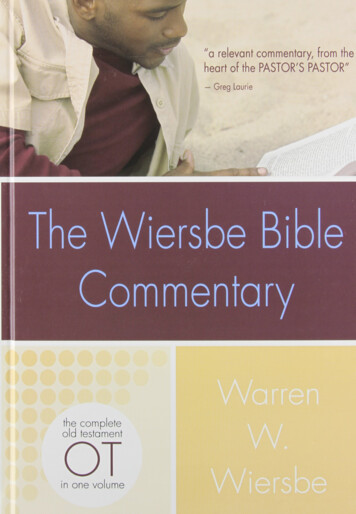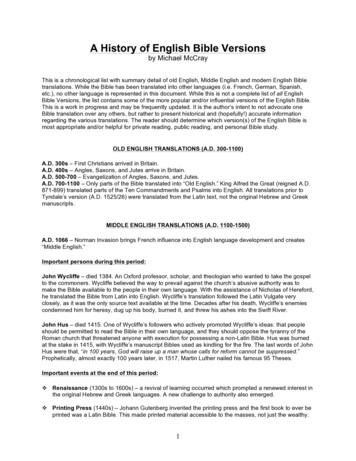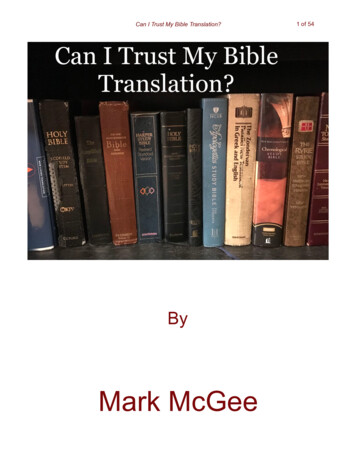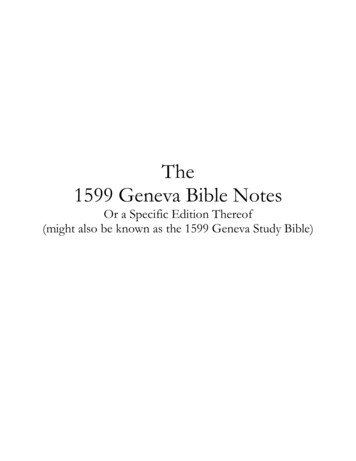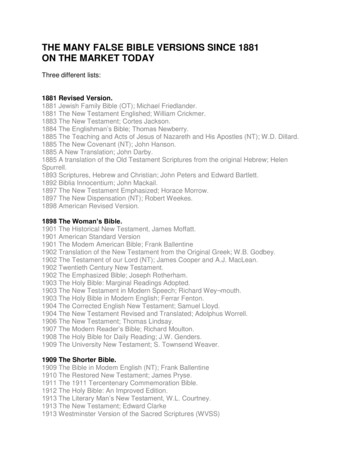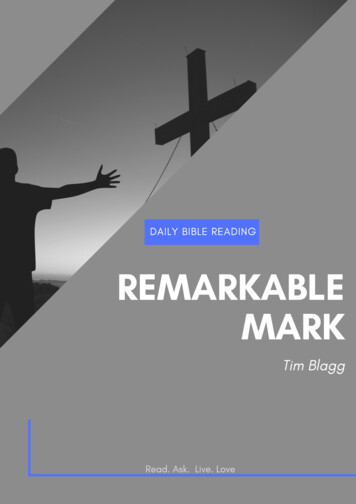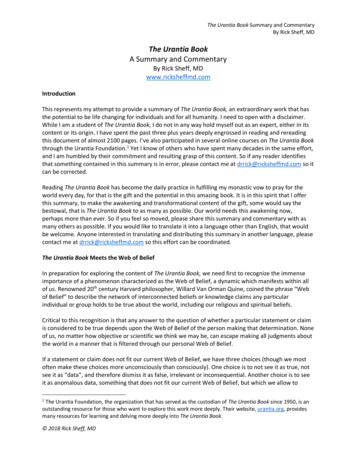
Transcription
The Wiersbe BibleCommentary
The Wiersbe BibleCommentarythe completenew testamentNTin one volumeWarrenW.Wiersbe
THE WIERSBE BIBLE COMMENTARY: NEW TESTAMENTPublished by David C. Cook4050 Lee Vance ViewColorado Springs, CO 80918 U.S.A.David C. Cook Distribution Canada55 Woodslee Avenue, Paris, Ontario, Canada N3L 3E5David C. Cook U.K., Kingsway CommunicationsEastbourne, East Sussex BN23 6NT, EnglandDavid C. Cook and the graphic circle C logoare registered trademarks of Cook Communications Ministries.All rights reserved. Except for brief excerpts for review purposes,no part of this book may be reproduced or used in any formwithout written permission from the publisher.LCCN 2007934009ISBN 978-0-7814-4539-9 2007 Warren W. WiersbeFirst edition titled The Bible Exposition Commentary by Victor Books , 2003 Cook CommunicationsMinistries, ISBNs 1-56476-031-6, 1-56476-030-8.Cover Photo: Jamie Grill/CorbisCover Design: Morris & WinrowPrinted in ItalySecond Edition 20071 2 3 4 5 6 7 8 9 10073107
CO N T E N T SMatthewMarkLukeJohnActsRomans1 CorinthiansFOREWORDMATTHEWMARKLUKEJOHNACTSROMANS1 CORINTHIANS2 1 THESSALONIANS2 1 Thessalonians2 1 Timothy2 TimothyTitusPhilemonHebrewsJames1 Peter2 THESSALONIANS1 TIMOTHY2 TIMOTHYTITUSPHILEMONHEBREWSJAMES1 PETER2 PETER1 JOHN2 JOHN3 ion7317477717877978018478919299591009101510211035
FTO R E W O R Dhe Wiersbe Bible Commentary had a modest beginning in 1972 when Victor Books published my commentary on 1 John and called it Be Real. Nobody remembers who namedthe book, but for me it was the beginning of three decades of intensive Bible study as Iwrote additional commentaries, all of them falling under the new “Be” series. It took twentythree books to cover the New Testament, and they were published in two bound volumes in1989. Then I started the Old Testament “Be” series; and Be Obedient, on the life of Abraham,was published in 1991. There are now forty-two books available in the entire series, and compiled together to create the Wiersbe Bible Commentary, this publication represents theculmination of over thirty years of joyful work. During this time I was writing books for several publishers, but writing the next “Be” book was always at the top of my agenda.I owe a great debt of gratitude to the editorial staff for their encouragement and cooperation these many years, including Mark Sweeney, Jim Adair, Lloyd Cory, and Greg Clouse.Greg was always faithful to “shepherd” me through book after book, and I appreciate hisfriendship and ministry more and more with each passing year. Every author should be as fortunate as I’ve been to work with such dedicated, skillful people who always take a personalinterest in their authors. To the best of my knowledge, during these years we’ve ministeredtogether, we’ve never had a cross word or a serious misunderstanding.I especially want to thank the Lord for His kindness and mercy in allowing me to ministerin this way through the printed page. I can think of many of my friends who could have donea far better job than I in this series, but the Lord graciously gave the privilege to me. He alsogave me the wisdom and strength to get each book written on time—and sometimes ahead oftime—in the midst of a very busy life as a husband and father, a pastor, a radio Bible teacher,a seminary instructor, and a conference speaker.This leads me to say that I couldn’t have done it without the loving care of my wife, Betty.She manages our household affairs so well and takes such good care of me that I’ve always hadthe time needed for studying and writing. When I started this series, our four children wereall at home. Now they’re all married, and my wife and I have many wonderful grandchildren!Time flies when you’re checking proofs!The numerous readers of the “Be” series have been a great source of encouragement to me,even when they have written to disagree with me! I have received letters from many parts ofthe world, written by people in various walks of life, and they have gladdened my heart. Unlessa writer hears from readers, the writing becomes a one-way street; and he or she never knowsif that writing did anybody any good. I want to thank the pastors, missionaries, Sunday school
Forewordteachers, and other students of the Word, who have been kind enough to write. We couldcompile a book of letters telling what God has done in the lives of people who have studiedthe “Be” series. To God be the glory!As I close, there are some other people whom ought to be thanked: Dr. Donald Burdicktaught me New Testament at Northern Baptist Seminary and showed me how to study theWord of God. Dr. Lloyd Perry and the late Dr. Charles W. Koller both taught me how to“unlock” a Scripture passage and organize an exposition that was understandable and practical. I recommend their books on preaching to any preacher or teacher who wants to organizematerial better.For ten happy years, I was privileged to pastor the Calvary Baptist Church in Covington,Kentucky, just across the river from Cincinnati. One of my happy duties was writing Biblestudy notes for “The Whole Bible Study Course,” which was developed by the late Dr. D. B.Eastep, who pastured the church for thirty-five fruitful years. I can’t think of a church that hasa greater love for the Bible or a deeper hunger for spiritual truth than the dear people ofCalvary Baptist. The “Be” series is, in many respects, a by-product of Dr. Eastep’s kindness insharing his ministry with me, and the church’s love and encouragement while I was their pastor. I honor his memory and thank God for their continued friendship and prayer support.Now, to you who study God’s Word with me, “I commend you to God, and to the wordof His grace, which is able to build you up, and to give you and inheritance among all themwho are sanctified” (Acts 20:32).—Warren W. Wiersbe8
MAT T H E WMatthewMarkLukeJohnActsRomans1 Corinthians2 1 Thessalonians2 Thessalonians1 Timothy2 TimothyTitusPhilemonHebrewsJames1 PeterOUTLINECONTENTSKey theme: The King and His kingdomKey verses: Matthew 2:2; 4:17Matthew 1—2I. THE REVELATION OF THE KING (1—10)A. His person—1—4B. His principles—5—7C. His ere’s Good News!12The King’s BirthMatthew 3—415The King’s CredentialsMatthew 518The King’s Principles: True RighteousnessII. THE REBELLION AGAINST THE KING (11—13)A. His messenger rejected—11:1–19B. His works denied—11:20–30C. His principles refused—12:1–21D. His person attacked—12:22–50E. Result: the “mysteries of the kingdom”—13Matthew 621The King’s Principles: True WorshipMatthew 724The King’s Principles: True JudgmentMatthew 8—927The King’s PowerIII. THE RETIREMENT OF THE KING (14—20)(The Lord seeks to leave theultitudes to bealone with His disciples.)A. Before Peter’s confession—14:1—16:12B. Peter’s confession—16:13–28(First mention of the cross—16:21)C. After Peter’s confession—17:1—20:34(Second mention of the cross—17:22)(Third mention of the cross—20:17–19)IV. THE REJECTION OF THE KING (21—27)(“The kingdom of God shall be taken fromyou,” 21:43.)A. His public presentation as King—21:1–16B. His conflict with the rulers—21:17—23:39C. His prophetic message—24—25D. His suffering and death—26—27V. THE RESURRECTION OF THE KING (28)Matthew 1030The King’s AmbassadorsMatthew 11—1233The King’s ConflictsMatthew 1337The King’s SecretsMatthew 1440The King’s WithdrawalMatthew 1543The King’s ConcernMatthew 1646The King’s SurpriseMatthew 1749The King’s GloryMatthew 1852The King’s RebukeMatthew 19:1–15The King’s Instructions56
MatthewMatthew 19:16—20:3459The King’s DemandsMatthew 21:1—22:1462656770CHAPTER ONEHERE’S GOOD NEWS!wenty or thirty years after Jesus had gone back toheaven, a Jewish disciple named Matthew wasinspired by the Spirit of God to write a book. Thefinished product is what we know today as “TheGospel According to Matthew.”Nowhere in the four gospels do we find a singlerecorded word that Matthew spoke. Yet in his gospel,he gives us the words and works of Jesus Christ, “theSon of David, the Son of Abraham” (Matt. 1:1).Matthew did not write to tell us about himself. But let’sget acquainted with him and the book he wrote. Thenwe can learn all that he wanted us to know about JesusChrist.The Holy Spirit used Matthew to accomplish threeimportant tasks in the writing of his gospel.The Bridge-Builder: He Introduced a New BookThat book was the New Testament. If a Bible readerwere to jump from Malachi into Mark, or Acts, orRomans, he would be bewildered. Matthew’s gospel isthe bridge that leads us out of the Old Testament andinto the New Testament.The theme of the Old Testament is given in Genesis5:1: “This is the book of the generations of Adam.”The Old Testament gives the history of “the Adamfamily,” and it is a sad history indeed. God created manin His own image, but man sinned—thus defiling anddeforming that image. Then man brought forth children “in his own likeness, after his image” (Gen. 5:3).These children proved themselves to be sinners liketheir parents. No matter where you read in the OldTestament, you meet sin and sinners.But the New Testament is “The book of the generation of Jesus Christ” (Matt. 1:1). Jesus is the lastAdam (1 Cor. 15:45), and He came to earth to save the“generations of Adam.” (This includes you and me, bythe way.) Through no choice of our own, we were borninto the generations of Adam, and this made us sin-A.His person—1—4THE REVELATION OF THE KING (1—10)TI.Matthew 26:57—27:2679Matthew 27:27–6682The King’s Suffering and DeathThe King’s Return—Part I1076The King’s TrialThe King’s DenunciationMatthew 24:1–44Matthew 26:1–56The King’s PreparationThe King’s DefenseMatthew 2373The King’s Return—Part 2The King’s JudgmentsMatthew 22:15–46Matthew 24:45—25:46Matthew 2884The King’s Victoryners. But by a choice of faith, we can be born into thegeneration of Jesus Christ and become the children ofGod!When you read the genealogy in Genesis 5, therepeated phrase and he died sounds like the tolling of afuneral bell. The Old Testament illustrates the truththat “the wages of sin is death” (Rom. 6:23). But whenyou turn to the New Testament, that first genealogyemphasizes birth and not death! The message of theNew Testament is that “the gift of God is eternal lifethrough Jesus Christ our Lord” (Rom. 6:23).The Old Testament is a book of promise, while theNew Testament is a book of fulfillment. (To be sure,there are many precious promises in the NewTestament, but I am referring to the emphasis of eachhalf of the Bible.) Beginning with Genesis 3:15, Godpromised a Redeemer; and Jesus Christ fulfilled thatpromise. Fulfilled is one of the key words in the gospelof Matthew, used about fifteen times.One purpose of this gospel is to show that JesusChrist fulfilled the Old Testament promises concerningthe Messiah. His birth at Bethlehem fulfilled Isaiah7:14 (Matt. 1:22–23). Jesus was taken to Egypt forsafety, and this fulfilled Hosea 11:1 (Matt. 2:14–15).When Joseph and the family returned and decided tosettle in Nazareth, this fulfilled several Old Testamentprophecies (Matt. 2:22–23). Matthew used at least 129quotations or allusions to the Old Testament in thisgospel. He wrote primarily for Jewish readers to showthem that Jesus Christ was indeed their promisedMessiah.The Biographer: He Introduced a New KingNone of the four gospels is a biography in the modernsense of the word. In fact, the apostle John doubtedthat a complete biography of Jesus could ever be written (John 21:25). There are many details about theearthly life of Jesus that are not given in any of theGospels.Each of the four gospels has its own emphasis.Matthew’s book is called, “the gospel of the King.” Itwas written primarily for Jewish readers. Mark’s book,
Matthewthe gospel of the Servant, was written to instructRoman readers. Luke wrote mainly to the Greeks andpresented Christ as the perfect “Son of Man.” John’sappeal is universal, and his message was “This is theSon of God.” No one gospel is able to tell the wholestory as God wants us to see it. But when we put thesefour gospel accounts together, we have a composite picture of the person and work of our Lord.Being accustomed to keeping systematic records,Matthew gave us a beautifully organized account of ourLord’s life and ministry. The book can be divided intoten sections in which “doing” and “teaching” alternate.Each teaching section ends with “When Jesus hadended these sayings” or a similar transitional statement.The chapters can be divided like 1—23:3924:1—25:4626:1—28:20 (the Passion narrative)Transition7:2811:113:5319:126:1Matthew described Jesus as the Doer and theTeacher. He recorded at least twenty specific miraclesand six major messages: the Sermon on the Mount(chaps. 5—7), the charge to the apostles (chap. 10), theparables of the kingdom (chap. 13), the lesson on forgiveness (chap. 18), the denunciation of the Pharisees(chap. 23), and the prophetic discourse on the Mountof Olives (chaps. 24—25). At least 60 percent of thisbook focuses on the teachings of Jesus.Remember, Matthew focuses on the kingdom. Inthe Old Testament, the Jewish nation was God’s kingdom on earth: “And you shall be unto me a kingdomof priests, and an holy nation” (Ex. 19:6). Many people in Jesus’ day were looking for the God-sentDeliverer who would release them from Romanbondage and reestablish the glorious kingdom of Israel.The message of the kingdom of heaven was firstpreached by John the Baptist (Matt. 3:1–2). The LordJesus also preached this message from the very beginning of His ministry (Matt. 4:23). He sent out thetwelve apostles with the same proclamation (Matt.10:1–7).However, the good news of the kingdom required amoral and spiritual response from the people, and notsimply the acceptance of a ruler. John the Baptist calledfor repentance. Likewise, Jesus made it clear that Hehad not come to overcome Rome, but to transform thehearts and lives of those who trusted Him. Before Hecould enter into the glory of the kingdom, Jesusendured the suffering of the cross.One further word about this gospel. Matthewarranged his material in a topical order, rather thanchronological. He grouped ten miracles together inchapters 8—9 instead of putting them into their historical sequence in the gospel’s narrative. Certain otherevents are totally omitted. By consulting a good harmony of the Gospels, you will see that, while Matthewdoes not contradict the other three gospel writers, hedoes follow his own pattern.Matthew was not only a bridge-builder who introduced a new book, the New Testament; and abiographer who introduced a new King, Jesus Christ;but he also accomplished a third task when he wrotehis book.The Believer: He Introduced a New PeopleThis new people, of course, was the church. Matthewis the only gospel writer to use the word church (Matt.16:18; 18:17). The Greek word translated churchmeans “a called-out assembly.” In the New Testament,for the most part, this word refers to a local assembly ofbelievers. In the Old Testament, Israel was God’scalled-out people, beginning with the call of Abraham(Gen. 12:1ff.; Deut. 7:6–8). In fact, Stephen called thenation of Israel “the church [assembly] in the wilderness” (Acts 7:38), for they were God’s called-outpeople.But the New Testament church is a different people, for it is composed of both Jews and Gentiles. Inthis church there were no racial distinctions (Gal.3:28). Even though Matthew wrote primarily for theJews, he has a “universal” element in his book thatincludes the Gentiles. For example, Gentile leaderscame to worship the Infant Jesus (Matt. 2:1–12). Jesusperformed miracles for Gentiles and even commendedthem for their faith (Matt. 8:5–13; 15:21–28). TheGentile Queen of Sheba was praised for her willingnessto make a long journey to hear God’s wisdom (Matt.12:42). At a crisis hour in Jesus’ ministry He turned toa prophecy about the Gentiles (Matt. 12:14–21). Evenin the parables, Jesus indicated that the blessings whichIsrael refused would be shared with the Gentiles (Matt.22:8–10; 21:40–46). The Olivet Discourse stated thatthe message would go “unto all nations” (Matt. 24:14);and the Lord’s commission involves all nations (Matt.28:19–20).There were only believing Jews and believing Jewishproselytes in the church at the beginning (Acts 2—7).When the gospel went to Samaria (Acts 8), people whowere part Jewish and part Gentile came into the church.When Peter went to the household of Cornelius (Acts10), the Gentiles became fully accepted in the church.The Conference at Jerusalem (Acts 15) settled the decision that a Gentile did not have to become a Jew beforehe could become a Christian.But Matthew anticipated all of this. And when hisbook was read by members of the early church, bothJews and Gentiles, it helped to settle differences andcreate unity. Matthew made it clear that this new people, the church, must not maintain a racial or socialexclusiveness. Faith in Jesus Christ makes believers “allone” in the body of Christ, the church.Matthew’s own experience with the Lord is recordedin Matthew 9:9–17, and it is a beautiful example of the11
Matthew 1grace of God. His old name was Levi, the son ofAlphaeus (Mark 2:14). “Matthew” means “the gift ofGod.” Apparently, the name was given to commemorate his conversion and his call to be a disciple.Remember that tax collectors were among the mosthated people in Jewish society. To begin with, theywere traitors to their own nation because they “soldthemselves” to the Romans to work for the government. Each tax collector purchased from Rome theright to gather taxes, and the more he gathered, themore he could keep. They were considered thieves aswell as traitors, and their constant contacts withGentiles made them religiously suspect, if not unclean.Jesus reflected the popular view of the publicans whenHe classified them with harlots and other sinners(Matt. 5:46–47; 18:17); but it was obvious that He wasthe “friend of publicans and sinners” (Matt. 11:19;21:31–32).Matthew opened his heart to Jesus Christ andbecame a new person. This was not an easy decision forhim to make. He was a native of Capernaum, andCapernaum had rejected the Lord (Matt. 11:23).Matthew was a well-known businessman in the city,and his old friends probably persecuted him. CertainlyMatthew lost a good deal of income when he left all tofollow Christ.Matthew not only opened his heart, but he alsoopened his home. He knew that most, if not all, of hisold friends would drop him when he began to followJesus Christ, so Matthew took advantage of the situation and invited them to meet Jesus. He gave a greatfeast and invited all the other tax collectors (some ofwhom could have been Gentiles), and the Jewish people who were not keeping the law (“sinners”).Of course, the Pharisees criticized Jesus for daringto eat with such a defiled group of people. They eventried to get the disciples of John the Baptist to create adisagreement (Luke 5:33). The Lord explained why Hewas fellowshipping with “publicans and sinners”: Theywere spiritually sick and needed a physician. He hadnot come to call the righteous because there were norighteous people. He came to call sinners, and thatincluded the Pharisees. Of course, His critics did notconsider themselves “spiritually sick,” but they werejust the same.Matthew not only opened his heart and home, buthe also opened his hands and worked for Christ.Alexander Whyte of Edinburgh once said that whenMatthew left his job to follow Christ, he brought hispen with him! Little did this ex-publican realize thatthe Holy Spirit would one day use him to write the firstof the four gospels in the New TestamentAccording to tradition, Matthew ministered inPalestine for several years after the Lord’s return toheaven, and then made missionary journeys to the Jewswho were dispersed among the Gentiles. His work isassociated with Persia, Ethiopia, and Syria, and sometraditions associate him with Greece. The NewTestament is silent on his life, but this we do know:12Wherever the Scriptures travel in this world, the gospelwritten by Matthew continues to minister to hearts.CHAPTER TWOMatthew 1—2THE KING’S BIRTHIf a man suddenly appears and claims to be a king, thepublic immediately asks for proof. What is his background? Who pays homage to him? What credentialscan he present? Anticipating these important questions, Matthew opened his book with a careful accountof the birth of Jesus Christ and the events that accompanied it. He presented four facts about the King.The Heredity of the King (1:1–25)Since royalty depends on heredity, it was important forJesus to establish His rights to David’s throne. Matthewgave His human heredity (Matt. 1:1–17) as well as Hisdivine heredity (Matt. 1:18–25).His human heredity (vv. 1–17). Genealogies werevery important to the Jews, for without them theycould not prove their tribal memberships or their rightsto inheritances. Anyone claiming to be “the Son ofDavid” had to be able to prove it. It is generally concluded that Matthew gave our Lord’s family treethrough His foster father, Joseph, while Luke gaveMary’s lineage (Luke 3:23ff.).Many Bible readers skip over this list of ancient(and, in some cases, unpronounceable) names. But this“list of names” is a vital part of the gospel record. Itshows that Jesus Christ is a part of history, that all ofJewish history prepared the way for His birth. God inHis providence ruled and overruled to accomplish Hisgreat purpose in bringing His Son into the world.This genealogy also illustrates God’s wonderfulgrace. It is most unusual to find the names of womenin Jewish genealogies, since names and inheritancescame through the fathers. But in this list we find references to four women from Old Testament history:Tamar (Matt. 1:3), Rahab and Ruth (Matt. 1:5), andBathsheba “the wife of Uriah” (Matt. 1:6).Matthew clearly omitted some names from thisgenealogy. Probably, he did this to give a systematicsummary of three periods in Israel’s history, each withfourteen generations. The numerical value of theHebrew letters for “David” equals fourteen. Matthewprobably used this approach as a memory aid to helphis readers remember this difficult listBut there were many Jewish men who could tracetheir family back to King David. It would take more thanhuman pedigree to make Jesus Christ “the Son of David”and heir to David’s throne. This is why the divine heredity was so important.His divine heredity (vv. 18–25). Matthew 1:16and 18 make it clear that Jesus Christ’s birth was different from that of any other Jewish boy named in the
Matthew 1—2genealogy. Matthew pointed out that Joseph did not“beget” Jesus Christ. Rather, Joseph was the “husbandof Mary, of whom was born Jesus, who is calledChrist.” Jesus was born of an earthly mother withoutthe need of an earthly father. This is known as the doctrine of the virgin birth.Every child born into the world is a totally newcreature. But Jesus Christ, being eternal God (John1:1, 14), existed before Mary and Joseph or any of Hisearthly ancestors. If Jesus Christ were conceived andborn just as any other baby, then He could not beGod. It was necessary for Him to enter this worldthrough an earthly mother, but not to be begotten byan earthly father. By a miracle of the Holy Spirit, Jesuswas conceived in the womb of Mary, a virgin (Luke1:26–38).Some have raised the question that perhaps Marywas not a virgin. They say that Matthew 1:23 shouldbe translated “young woman.” But the word translatedvirgin in this verse always means virgin and cannot betranslated “young woman.”Both Mary and Joseph belonged to the house ofDavid. The Old Testament prophecies indicated thatthe Messiah would be born of a woman (Gen. 3:15), ofthe seed of Abraham (Gen. 22:18), through the tribe ofJudah (Gen. 49:10), and of the family of David (2Sam. 7:12–13). Matthew’s genealogy traced the linethrough Solomon, while Luke’s traced it throughNathan, another one of David’s sons. It is worth noting that Jesus Christ is the only Jew alive who canactually prove His claims to the throne of David! All ofthe other records were destroyed when the Romanstook Jerusalem in AD 70.To the Jewish people in that day, betrothal (engagement) was equivalent to marriage—except that theman and woman did not live together. They werecalled “husband and wife,” and, at the end of theengagement period, the marriage was consummated. Ifa betrothed woman became pregnant, it was considered adultery (see Deut. 22:13–21). But Joseph did notpunish or divorce Mary when he discovered she waswith child, for the Lord had revealed the truth to him.All of this fulfilled Isaiah 7:14.Before we leave this important section, we mustconsider the three names assigned to God’s Son. Thename Jesus means “Savior” and comes from the Hebrewname Joshua (“Jehovah is salvation”). There were manyJewish boys with the name Joshua (or, in the Greek,Jesus), but Mary’s Boy was called “Jesus the Christ.”The word Christ means “anointed”; it is the Greekequivalent of Messiah. He is “Jesus the Messiah.” Jesusis His human name; Christ is His official title; andEmmanuel describes who He is—“God with us.” JesusChrist is God! We find this name “Emmanuel” inIsaiah 7:14 and 8:8.The King, then, was a Jewish male who is also thedivine Son of God. But, did anybody acknowledge Hiskingship? Yes, the magi from the East came and worshipped Him.The Homage to the King (2:1–12)We must confess that we know little about these men.The word translated “wise men” (magi) refers to agroup of scholars who studied the stars. Their title connects them with magic, but they were probably morelike astrologers. However, their presence in the biblicalrecord is not a divine endorsement of astrology.God gave them a special sign, a miraculous star thatannounced the birth of the King. The star led them toJerusalem, where God’s prophets told them that theKing would be born in Bethlehem. They went toBethlehem, and there they worshipped the Christ Child.We do not know how many magi there were. Fromthe three gifts listed in Matthew 2:11, some peoplehave assumed there were three kings from the Orient,though this is not certain. But when their caravanarrived in Jerusalem, there were enough of them totrouble the whole city.Keep in mind that these men were Gentiles. Fromthe very beginning, Jesus came to be “the Savior of theworld” (John 4:42). These men were also wealthy, andthey were scholars—scientists in their own right. Noscholarly person who follows the light God gives himcan miss worshipping at the feet of Jesus. In JesusChrist “are hid all the treasures of wisdom and knowledge” (Col. 2:3). In Him dwells “all the fullness of theGodhead bodily” (Col. 2:9).The magi were seeking the King, but Herod wasafraid of the King and wanted to destroy Him. Thiswas Herod the Great, called king by the Roman senatebecause of the influence of Mark Antony. Herod was acruel and crafty man who permitted no one, not evenhis own family, to interfere with his rule or prevent thesatisfying of his evil desires. A ruthless murderer, hehad his own wife and her two brothers slain because hesuspected them of treason. He was married at least ninetimes in order to fulfill his lusts and strengthen hispolitical ties.It is no surprise that Herod tried to kill Jesus, forHerod alone wanted to bear the title “King of theJews.” But there was another reason. Herod was not afull-blooded Jew; he was actually an Idumaean, adescendant of Esau. This is a picture of the old struggle between Esau and Jacob that began even before theboys were born (Gen. 25:19–34). It is the spiritual versus the carnal, the godly versus the worldly.The magi were seeking the King; Herod was opposing the King; and the Jewish priests were ignoring theKing. These priests knew the Scriptures and pointedothers to the Savior, but they would not go to worshipHim themselves! They quoted Micah 5:2 but did notobey it. They were five miles from the very Son of God,yet they did not go to see Him! The Gentiles soughtand found Him, but the Jews did not.Matthew 2:9 indicates that the miraculous star wasnot always visible to the magi. As they started towardBethlehem, they saw the star again; and it led them tothe house where Jesus was. By now, Joseph had movedMary and the baby from the temporary dwelling where13
Matthew 2the Lord Jesus had been born (Luke 2:7). The traditional manger scenes that assemble together theshepherds and wise men are not true to Scripture, sincethe magi arrived much later.Matthew cites a second fulfilled prophecy to provethat Jesus Christ is the King (Matt. 2:5). How He wasborn was a fulfillment of prophecy, and where Hewas born was a fulfillment of prophecy. Bethlehemmeans “house of bread,” and this was where the “Bread ofLife” came to earth (John 6:48ff.). Bethlehem in the OldTestament was associated with David, who was a type ofJesus Christ in His suffering and glory.Hostility against the King (2:13–18)A person is identified not only by his friends, but alsoby his enemies. Herod pretended that he wanted toworship the newborn King (Matt. 2:8), when in realityhe wanted to destroy Him. God warned Joseph to takethe child and Mary and flee to Egypt. Egypt was close.There were many Jews there, and the treasures receivedfrom the magi would more than pay the expenses fortraveling and living there. But there was also anotherprophecy to fulfill, Hosea 11:1: “I called my Son out ofEgypt.”Herod’s anger was evidence of his pride; he couldnot permit anyone to get the best of him, particularlysome Gentile scholars! This led him to kill the boybabies two years of age and under who were still inBethlehem. We must not envision hundreds of littleboys being killed, for
The Old Testament is a book of promise, while the New Testament is a book of fulfillment. (To be sure, there are many precious promises in the New Testament, but I am referring to the emphasis of
